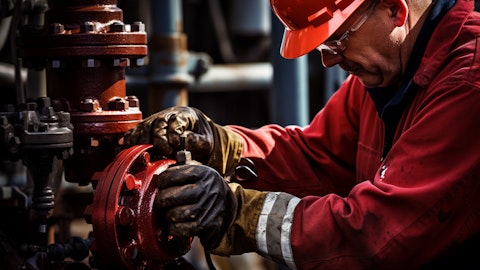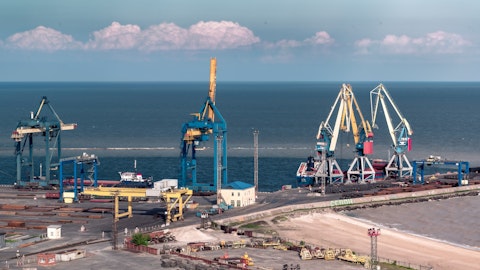So they have to get additional capacity either through consolidation or by expanding their capital budgets and building plant, whereas we’ve invested in the technology, and the technology and then the system of going from an engineering to order to a configure to order allows us to have that additional cadence through the plant. So again, allowing us to expand far beyond the traditional theoretical capacity. So look, we monitor the situation very closely. We’re very open. We share it with our clients. We’re having very long-term discussions, well beyond the time period that we would traditionally be having discussions, and they have the confidence to have those discussions with us because of this new operating model and they see that we — they understand that we are doing things that will allow us to have the capacity to continue to expand and deliver and support their projects.
James West: Okay, guys. Very helpful, Doug. And then I thought some of the first-time awards, particularly on the carbon capture side, were fascinating. Could you maybe expand on this use of the C4 for CCS? And was this contemplated initially as we targeted these projects and if so, are additional offshore projects all targeting that? And then is the technology — are you using kind of existing technology, or is this new novel technology?
Doug Pferdehirt: Both great questions. So look, we’ve been working on this for quite some time and you know, James, as you know, we kind of — we look at any challenge from the seafloor up and I think we might be the only company that really takes that approach because most companies and quite frankly most developers kind of think about onshore and then if they go offshore, they want to have some sort of fixed bottom, like a monopower or something that is touching the seafloor. Or if they go further offshore, they want to have some sort of a floating structure. We fundamentally believe the right way to do it is to eliminate the greenhouse footprint associated with those structures, is to put everything on the seafloor, but it takes very advanced technology, material science, automation, and controls that quite frankly there’s very few places in the industry, but beyond the industry, in academia, etcetera, that really exist today and we’re proud that’s where we operate.
We’re putting things one to two miles deep in the water on the seafloor, designed to last for 25-year to a 35-year life with all advanced automation, robotics and controls that quite frankly challenge anything that’s being done in the industry or beyond the industry today. So when we look at a challenge like CCS, sure, we can be involved in a terrestrial project and happy to be involved in those projects, but fundamentally, we believe that the safest and best place to store the CO2 will be in saline or abandoned aquifer or abandoned depleted reservoirs, far offshore and they exist. They’re well known. You can then transport from shore all the way out to those, into those injection fields, all subsea without having any sort of a floating infrastructure as being demonstrated in the Northern Endurance Partnership project as we described.
From a technology point of view, it is important to note there are people that believe you can just reverse the flow and use existing oil and gas infrastructure. That’s not true. It is much more of a technical challenge than that would make one believe. I talked a little bit about the tree and the tree design, the valves on the tree as I explained. It also comes down to the control and automation and also the monitoring that’s required on these projects. So we have developed an entire, what we again call an integrated carbon transportation system that allows us to take it basically from the host facility to an injection point and we definitely see the trend and not just in CCS but also in other forms of energy and new energies that are really for them to reach their fullest potential to achieve the scale that is required.
We see this going offshore and that is certainly the trend and one that we are helping to enable and we’re proud to do so.
James West: Got it. Thanks Doug.
Operator: Our next question comes from the line of Luke Lemoine with Piper Sandler. Please go ahead.
Luke Lemoine: Hey, good morning Doug. You recapped the merits of an all-electric subsea already and you had the first announcement with northern endurance for CCS.
Doug Pferdehirt: Luke, you dropped off Luke. If you don’t mind repeating the question, you dropped off Luke.
Luke Lemoine: Yeah, sure. Just talking about the first all-electric system for Northern Endurance for CCS, when you kind of look at oil and gas, when can we start seeing the uptake for all-electric and when you’re speaking with customers, what are the pinch points if there are any when you’re chatting with them?
Doug Pferdehirt: Sure, thank you Luke. Look, oil and gas is happening in parallel to the CCS opportunity. So you will see oil and gas opportunities using all-electric, full field development and I stress full field because, keep in mind, we’ve been using electric actuation for many years and we have over 600 all-electric actuators installed on subsea equipment, around the world. So that part of it is not novel, but to go to a fully electric system, which would include an electric subsurface safety valve would be unique and that’s a partnership for us that we’re working together with Halliburton to enable an all-electric subsea field development. But again, there’s commercial activity going on in parallel. So, you will see more in that area also.
I would stress though in the area of oil and gas that, I see the bigger opportunities in the tiebacks and why is that? Look, an all-electric tree is more expensive than a hydraulically, electro-hydraulically operated tree for all the right reasons. Now when you look at it from a tieback point of view, those economics dissipate very quickly because in a long distance tieback, the umbilical and the cost of the umbilical across that very long distance to be able to use hydraulic actuation would either be limiting, it would not be possible, or it would be very costly. But when you look at it on a unit cost versus a unit cost, an all-electric tree is more expensive. So therefore, in a greenfield development, I think those opportunities will be there, but the big market, and I stress it will be a significant market, will be in the area of brownfield.
We’ve talked about it before. If you look around the world at all the floating, the floating production assets that are out there today, FPSOs, FPSUs, they’re producing at between 60% and 70% of nameplate capacity. All-electric brownfield tiebacks will allow them to be able to bring that back up to near nameplate capacity without any significant capital cost and we’ve gotten the cycle time now on those brownfield projects down to such a level, slightly over one year, that it makes the economics very, very compelling.
Operator: Our next question comes from the line of Guillaume Delaby with Bernstein. Please go ahead.




